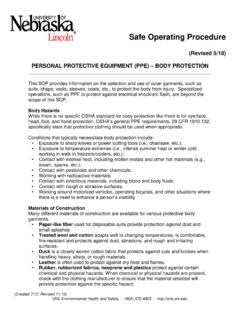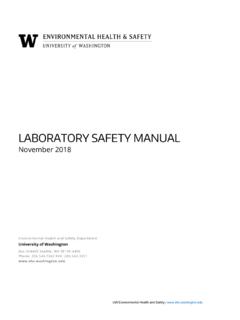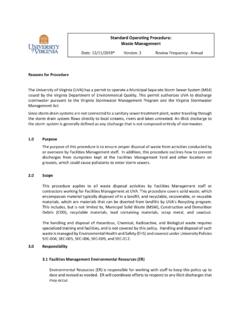Transcription of Laboratory Waste Disposal and Management
1 General Dates Active: February, 2020 Present Author: Tania B., Victoria W. Laboratory Waste Disposal and Management OVERVIEW. The procedure described in this document applies to any chemical substances that are classified hazardous'. A hazardous substance becomes hazardous Waste when it has served, or can no longer serve, its original intended use and is discarded, or stored in lieu of being discarded. The purpose of this document is to assist lab workers in the proper handling and Disposal of radioactive and hazardous chemical Waste according to EHS regulations, as well as dictate proper Disposal of excess reagents, spent water, and excess standards from the different instruments at the Water Sciences Laboratory . ANY. organic solvent OR radioactive material requires special handling including collection and tagging for EHS.
2 Sewer Disposal is only appropriate for inorganic solutions that do NOT contain regulated metals such as chromium, cadmium, lead, etc. STORAGE AND Disposal OF CHEMICAL Waste . In order to determine whether a chemical or reagent needs to be collected and tagged according to EHS. protocol, or if it can instead be disposed of in the sanitary sewer, refer to the EHS Sewer Disposal List, found in the folder on the wall, behind the analytical balance. Any container used to store hazardous Waste must be in good condition (tight-fitting lids, no leads, no corrosion, no rust, cracks, or serious dents). The collection container must be labeled as soon as collection begins. At a minimum, the container must be labeled with the fully written, proper chemical name of the material contained within, and wording to indicate if the chemicals are used, spent, excess, etc.
3 If a container is a mixture of chemicals, the container must be labeled with the names of all components in the mixture. If the material is identified by a trade name, include the proper chemical name in parenthesis, if known. Be sure that the container is compatible with the chemical Waste . Use containers that are made of or lined with materials which will not react with, and are otherwise compatible with, the hazardous Waste to be stored. The following table shows general chemical categories and compatible container type. Chemical Category Container Type Mineral acids Plastic Bases Plastic Oxidizers Glass Organics, including acetic acid Glass Waste containers must be closed at all times, except when being filled. Do NOT leave funnels in the containers. Do NOT place any types of vials inside a Waste container.
4 There is a separate Waste container for glass items and sharps. Only chemical Waste can be disposed of in Waste containers. Label the container properly (full chemical name; no abbreviations; approximate %). Fill out information as indicated on the Waste Calculation Sheet attached to, or sitting nearby, the container. Total up the approximate percent Waste when the container is full. Do not accumulate excessive Waste in the work area. The Laboratory should NOT have more than one container of each kind of Waste . Tag container when full and mail top copy to EHS (address is located on the Waste tag). Be sure that containers in the Waste storage area do not leak. Consider the use of secondary containment, such as a tray or larger container, to prevent a possible spill or leak from the Waste containers.
5 Waste stored near drains (floor, sink) or other non-designated areas (bench, fume hood) SHOULD have secondary containment that is compatible with the Waste . Like any chemical storage in the Laboratory or work area, be sure to segregate the containers according to the type of Waste . Chemical wastes that are incompatible should not be stored together. If these wastes must be stored in the same area, they should be physically separated to prevent the materials from contacting each other in the event of a spill or leak. NEVER store the following types of wastes near each other: - Acids and bases - Organics and acids - Cyanide, sulfide, or arsenic compounds and acids - Alkali or alkali earth metals, alkyl-lithiums, etc. and aqueous Waste - Powdered or reactive metals and combustible materials - Mercury or silver and ammonium containing compounds Disposal OF ACIDIC Waste .
6 Do not dispose the acidic Waste down the sewer directly. Dilute with tap water and pour into the plastic container, containing marble chips. This container is located in the acid lab sink in 205. The dilution is facilitated by running tap water at the same time as the acid (or base). For example, a faucet running at rate of 1 liter per minute produces a 1:10 dilution of 1 -liter of concentrated acid over 10 minutes. The acidic solution after coming in contact with the marble chips will neutralize it, after dilution, and the fluid will drain out into the outer container, that has additional drains, through which, the fluid, drains out into the sink drain and down the sewer. This bucket is referred to as the neutralization bucket in the Laboratory . Doing a dilution and neutralization in the sink will simplify Disposal of acidic solutions STORAGE AND Disposal OF RADIOACTIVE Waste .
7 Store and dispose of radioactive Waste (RAD) in the manner described in the previous section. Label container with the radiation trefoil symbol, the words Radioactive Material , and the isotope. Store it in the radioactive designated area. Collection containers must be separate from regular Waste . Dry non- hazardous Laboratory trash (paper, plastic, vials, etc) used for RAD work should be disposed in the RAD. trash, using a new liner and tagged for EHS pick up, after RAD work is complete, even if it is not full. The Radioactive Waste activity must be determined and reported on the EHS Waste collection tag, in mCi, prior to submittal. STORAGE AND Disposal OF Waste BY INSTRUMENT. AQ2. Excess AQ2 reagents, collected underneath the instrument, must be disposed of through UNL.
8 Environmental Health and Safety, and can be collected in gallon plastic bottles. Each Waste bottle must have an AQ2 Waste label and an EHS tag. Spent wash Waste can be disposed down the sewer. Waste labels can be found in the WSL Box folder under Lab Management > Templates and Labels > AQ2 Reagent Labels > AQ2 Waste Label. Spent water from the machine can be disposed of down the sanitary sewer. TOC/DOC. No Waste Disposal . The spent water from the machine drains out through the drain in the 203 fume hood. TOC/DOC reagents get used up during analysis. IC. There is no reagent Waste to dispose of, as all reagents run down a Waste line into a drain inside the hood behind the instrument. The regenerate and eluent usually get used up, but any excess can be disposed of down the sanitary sewer after dilution with tap water.
9 Lachat Spent water that collects in the Waste container underneath the machine can be disposed of down the sanitary sewer. Excess reagents should be collected in a Waste bottle of the appropriate material and tagged for collection by EHS. AA. Excess standards should be disposed into the neutralization bucket located in the 205 sink. ICP-MS. Spent water from the machine should be disposed into the neutralization bucket located in the 205 sink, and excess standards must be collected in a Waste container made of an appropriate material and tagged for collection by EHS. LC/MS. The Waste that is generated by the LC/MS is collected in a glass bottle below the instrument, and should be tagged for collection by EHS. It is primarily a mixture of water, methanol, and acetonitrile.
10 Excess standards, spiking solutions, and calibration solutions are suspended in solvent, but also contain high concentrations of analyte. This means they must be collected in a separate glass container. This should be labeled with all analytes that are present in approximate percentages, the approximate percentages of all solvents, and an EHS tag. GC/MS. The Waste that is generated by the GC/MS is collected in a glass bottle below the instrument, and should be tagged for collection by EHS. It is primarily a mixture of water, methanol, acetonitrile, and ethyl acetate. Excess standards, spiking solutions, and calibration solutions are suspended in solvent, but also contain high concentration of analyte. This means they must be collected in a separate glass container.







